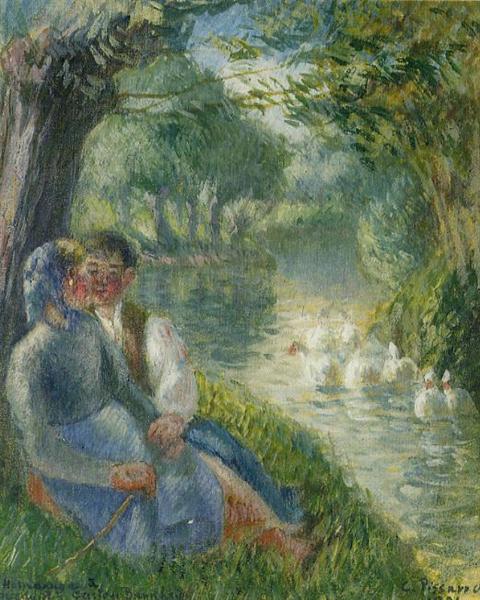Description
The painting "Lovers sitting at the foot of a Sauce" by Camille Pissarro, created in 1901, is a work that encapsulates the essence of impressionism, a style that the Danish-French artist dedicated much of his career. In this work, Pissarro presents an idyllic and evocative scene, in which two figures sitting under the shadow of a leafy weeping willow are appreciated. This choice of an intimate and serene natural environment highlights the connection between love and nature, a recurring theme in the painter's work.
At the compositional level, the painting is characterized by a careful organization of elements. The figures, a man and a woman, are found in the center of the canvas, surrounded by the lush vegetation that surrounds them almost protectively. This provision creates a sense of closeness and privacy, suggesting a moment of complicity among lovers. The inclination of the willow about them seems to caress the scene, as if nature itself shared this moment of tenderness and union.
The color palette used by Pissarro is rich and varied, predominantly composed of green tones that allude to the freshness of the natural environment, but also incorporates yellow and brown nuances that add warmth to the work. The shadows that are projected from the tree and on the figures are represented with subtlety, which allows the sunlight to be perceived to filtering between the leaves, creating a game of lights and shadows that is typical of the impressionist style. This use of light not only gives life and depth to painting, but also contributes to the charming and romantic atmosphere that is breathed.
The figures of lovers, although they are not accurately detailed, are presented in a suggestive way. The woman, dressed in a clear blouse and a dark skirt, bows towards her partner with a gesture that reflects affection and closeness. The man, with his simple clothing, seems to look at the woman, caught in the contemplation of her beauty. Its expressions are not completely defined, which allows the viewer to project their own interpretation of the scene. This approach to subtle emotionality and human relationships is a distinctive feature of Pissarro's work, who set out to capture not only the landscape, but also the daily experiences of life.
Camille Pissarro, one of the leaders of the impressionist movement, is known for its ability to represent everyday life and landscapes in a style that prioritizes visual perception and light on the details of the form. In "lovers sitting at the foot of a willow", the use of loose brushstrokes and vibrant colors reflects the changing nature of light and atmosphere, which allows spectators to immerse themselves in a world where nature and human emotions intertwine.
This work is within a broader corpus of Pissarro's work, where he constantly explored the relationship between the characters and their surroundings. Compared to contemporary works of other impressionists such as Claude Monet or Pierre-Auguste Renoir, a similar narrative line can be observed in the representation of intimacy and nature. However, Pissarro's approach to rural life and personal interactions, as in this work, adds a distinctive nuance that separates it within the impressionist current.
"Lovers sitting at the foot of a willow" is, in essence, a tribute to the beauty of the moments shared in the serenity of nature. The work captures a transitory moment, a dolce vita that invites the viewer to contemplate the simplicity and depth of love, represented in a subtle and poetic way under the shelter of a willow. Pissarro's ability to merge human emotion with a sublime natural environment continues to resonate, turning this painting into a jewel of impressionism and a testimony of his artistic genius.
KUADROS ©, a famous paint on your wall.
Hand-made oil painting reproductions, with the quality of professional artists and the distinctive seal of KUADROS ©.
Reproduction service paintings With a guarantee of satisfaction. If you are not completely satisfied with the replica of your painting, we refund your money 100%.

